25 Points: Seiobo There Below
 |
Seiobo There Below
by László Krasznahorkai
New Directions, 2013
440 pages / $17.95 buy from Amazon
|
1. I almost laugh, attempting to write anything about the Krasznahorkai, since I’ve done an interview with the translator for The Paris Review, and feel my work is done here, and also since we are dealing with a nearly 500-page book that lashes out in chunks of twelve-page sentences, transcendent, dazzling, insane, hilarious, vicious and brutal, determinedly unexplainable and unexplained.
2. Transparency is not the hallmark of the Krasznahorkai.
3. But ok. This is the Hungarian writer at the forefront of a renaissance in Hungarian letters, an intense, experimental madman whose books are metaphysical puzzles of stunning originality and brilliance.
4. This is a man with burning eyes and a cheap suit, who shows up at Columbia to a packed house and reads…in the dark…in Hungarian…and kinda actually scares people.
5. There’s a quote from Susan Sontag on the back of Seiobo There Below that calls László Krasznahorkai “the Hungarian master of the apocalypse,” which is intimidating, and doesn’t sound like much fun. Do not be scared away; this book is a pleasure to read, and even funny.
6. The last chapter is named “Screaming Beneath the Earth,” which is a reverse riff on the first phrase of Gravity’s Rainbow, “A screaming comes across the sky…”, and gives an idea of the author’s ambition. The book is an incoming rocket, taking on the small matter of the power and transcendence of art.
7. Krasznahorkai has the interesting idea, though I’m not sure I’m convinced, that good art is dangerous. Art in this book tends to overpower ordinary people or drive them insane. Is this pretentious? Probably, right? Real migrant workers are not often driven mad by the sight of glorious paintings.
8. But then again, I also believe in salvation through art. What is a God without destructive power?
9. Seiobo There Below is structured in a series of sections, mostly about artists making art, a few about tourists or exiles. Sections include a modern-day man visiting the Acropolis, a Japanese Noh actor speaking to his disciples, another Japanese artist making a mask, a stork hunting in a river, a Renaissance painter in his workshop, an immigrant in Barcelona.
10. Some quotes: “…to stand there, to look at this life withdrawing for all eternity into death in the human and natural landscape, and to depict what is before him when he looks up from the blank canvas: that is everything…”
July 31st, 2014 / 2:02 pm
Sortes Poundianae
 |
The Cantos of Ezra Pound
by Ezra Pound
New Directions, 1996
896 pages / $25.95 buy from Amazon
|
1. In the Middle Ages, as a practice of divination, as a method of drawing lots and to soothsay, to learn what might be the wrath to come, to draw out a linear progression from a dark mass of chaos, those with access to Virgil’s Aeneid might practice Sortes Vergilianae. The instructions were simple: fetch a copy of the epic poem, let the weary spine fall where it may, and whatever passage the eye lighted on the reader interpreted as indicative of prophecy.
2. My copy of The Cantos of Ezra Pound is a fresh New Directions paperback with the spine still intact. Regardless, it looks ominous. The backdrop black with serifed white letters stamped down on the cover. At twelve years old and knowing nothing of Ezra Pound, I picked the book up because it looked Biblical and heavy, like תֹהוּ וָבֹהוּ, the waters of Genesis 1:2.
3. The Cantos present chaos before the Spirit of God levitates over the deep. Although Pound principally brings forward “light” as his favorite element of spirituality and mysticism, darkness pervades the poem. It’s universally acknowledged that the work turns on an axis based more on Inferno than Paradiso.
4. Interviewed by Donald Hall in The Paris Review, who spent three days with Pound in Italy during the early 1960s, a restless and writer’s block-inflicted Pound comments, “It is difficult to write a paradiso when all the superficial indications are that you ought to write an apocalypse. It is obviously much easier to find inhabitants for an inferno.”
5. After publishing Thrones de los Cantares, the penultimate section of the Cantos, Pound admits, “Okay, I am stuck.” One imagines him gazing out the window, sunlight revealing a Roman street where, if you dig far enough, discoveries of pagan rites abound. He continues, pulling at his beard, “The question is, am I dead.”
6. The aforementioned Hebrew typically translates as “without form and void” (KJV). It can also mean “utter confusion,” a feeling most readers share when tackling the Cantos. Pound’s classic outline for his epic poem, from a letter to his father (who was appropriately, I kid you not, named Homer), begins, “Live man goes down into world of Dead.”
7. Pound, like his hero Odysseus, descended into Hell and still lived to see daylight. Kept outdoors for many weeks near Pisa, Pound was a caged panther, captive of the US military in 1943. During this time or immediately afterwards, he promptly went insane, dubbed mentally unfit to stand trial, housed in the “bughouse” of St. Elizabeths Hospital for thirteen years. As the story goes.
8. To draw lots, to soothsay out of an inferno, is simply not done. It reminds one of the Faust legend, or Robert Johnson’s railroad deal with the devil. Like a Oujia board for literary nerds (or, more properly, “bibliophiles”), a variety of sortes tempt many.
9. But The Cantos beckon. Suck a poor poet into their orbit. They are sirens. Robert Frost mentions, in a 1960 interview with the Paris Review, how Ezra Pound practiced jujitsu on him in a restaurant. “So I stood up, gave him my hand. He grabbed my wrist, tipped over backwards and threw me over his head.” Like its writer, the poem practices a similar sort of action on the reader.
July 29th, 2014 / 12:00 pm
The Mongolian Conspiracy
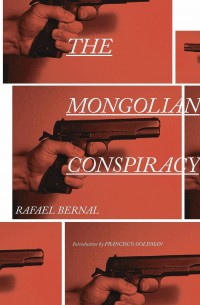 The Mongolian Conspiracy
The Mongolian Conspiracy
by Rafael Bernal, translated by Katherine Silver
New Directions, 2013
192 pages / $14.95 buy from Amazon or Powell’s
Rating: 9.0
The Mongolian Conspiracy, by Rafael Bernal, brings slick Noir tropes to 1960’s Mexico City. Ostensibly a political thriller, the action follows Filiberto Garcia, an aging veteran of the Mexican Revolution and killer-for-hire contracted by the police to investigate an assassination plot. These rumors, apparently originating from Mongolia, send Garcia on the prowl through the city’s gritty Chinatown, and as the plot unravels: farther and farther a field. The scenes trend pulpy: Garcia seduces a possible femme fatale, he shoots up an opium den, and he brings the investigation to a very Sam Spade finish. The novel has the sheen of 60’s political thrillers (The Day of the Jackal, Z, Topaz), especially as Garcia meets operatives from the CIA and KGB. But these encounters, madcap and witty, capture the tone that makes The Mongolian Conspiracy more compelling than any ordinary political thriller.
May 6th, 2014 / 12:00 pm
The Hour of the Star
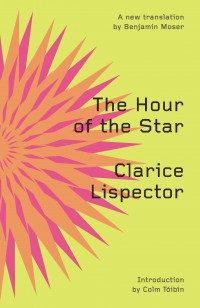 The Hour of the Star
The Hour of the Star
by Clarice Lispector
New Directions, 2011
128 pages / $12.95 buy from Amazon
Rating: 7.1
The Hour of the Star is about a poor, unattractive Brazilian woman named Macabéa who seems unaware of the doom and misery which (according to the author) characterize her entire existence. Did Lispector know a woman like this? Was Lispector like this when she was young? Was she like this even until her death? Nobody knows. Even if you don’t know anybody like this, you can imagine one, thanks to this book. The miracles of fiction. The glories of speculative mimesis.
Is it conceivable that the thoughts of readers will lead them toward sympathy for women in unenviable circumstances? Yes. Is it conceivable that the thoughts of readers will be unaltered and the book will act more as an acknowledgment of extant attitudes rather than a catalyst for new attitudes? Yes. Is it possible to know which is more likely? I don’t know. Consult the afterword. Compose a letter to the publisher in which you refer to the afterword.
The style will not appear new unless you haven’t read much 20th century literary fiction. Meta-flowage, what-have-you. It is easy to read, unlike some meta-flow-ers. Not that style matters. Style doesn’t matter, because it is indistinguishable from anything else. One can only distinguish things because they have been styled in a distinguishable manner. Therefore, when we talk about style, we only talk about the thing which is styled and nothing else. “Style” therefore might as well be just another word for “thing.” The atoms are gathering themselves back together again and before you know it, we’ll all be psychic skateboarders on mysterious Egyptian vert ramps. Lispector won’t be there. Macabéa might be though.
April 3rd, 2014 / 12:00 pm
Notes on Satantango (the Book and the Film) – Part 1/3
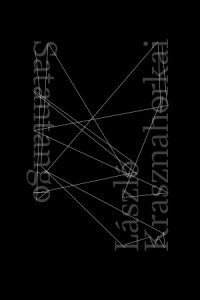 Satantango
Satantango
by László Krasznahorkai
Translated by George Szirtes
New Directions, 2012
288 pages / $25.95 Buy from New Directions or Amazon
&
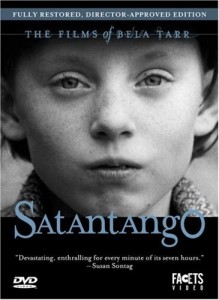 Satantango
Satantango
Directed by Béla Tarr
Screenplay by Lászlo Krasznahorkai
DVD: Facets Video, 2008
435 minutes / Available on Amazon
Released in Hungarian in 1985, Satantango, László Krasznahorkai’s first book, was translated into English only last year. Published by New Directions, the novel displays the melancholy, bleakness, and long sentences that define Krasznahorkai’s other books (War & War, The Melancholy of Resistance, etc.).
Krasznahorkai’s collaborator and fellow apocalypse maker Béla Tarr adapted the 288-page novel into a seven-hour film in 1994. Because of the duration between the appearance of the film and the publication of the English translation, we (like most) had watched Tarr’s adaptation long before reading its antecedent. This reversal of the traditional adaptation-viewing chronology (in addition to Krasznahorkai’s role as screenwriter) makes it difficult to think of the novel independent of the film. But despite the convergence of the two forms of Satantango, we do not believe the demands of the long take are the same as those of the long sentence.
What follows is a collection of take-by-take notes on disc one of the film and the corresponding passages of the novel. (Notes on discs two and three are forthcoming.) Our time stamps are based on the Facets Satantango DVD (2008). Throughout the notes, we acknowledge differences between the novel’s content and the film’s content, as well as translation differences between the novel and the DVD’s subtitles.
***
We see a cow emerge from behind the building, nothing in front of him but a vast scene of thick mud with glimmering streaks of wetness that resemble the trails that snails make when they zigzag across dark pavement. One cow becomes many, and they slowly make their way together. No one leads them or chases them but they seem to know their way. They take their time. They have, it seems, all the time in the world. One even pauses to mount another. This scene, though absent from the novel, sets a haunting tone of obliteration for the film. We watch the cows, then continue to watch, continue to watch past the time of watching, past the time of a simple a gaze or witnessing, look at them for so long that when the camera finally moves away from the herd of animals and pans past the dilapidated buildings, the mundane and bleak textures, the strange marks and letters, the utter signs of disintegration and decay become for us a relief. The wind howls and it feels like silence, yet it is not silent. We can hear the cows’ feet move through the mud, the mooing; the sounds are almost daunting, eerie. Without music (we keep waiting for it, hoping it will come to shake us out of the strange unreal reality of this scene, random sounds that seem to anticipate some cohesive and introductory soundtrack), the scene is discomforting but mesmerizing. Here, inside the muddy world we have found ourselves in, we learn to wait.
[1:35–9:06 / not in novel]
In voiceover:
“One October morning before the first drops of the long autumn rains, which turn tracks into bog, which cut the town off, which fell on parched soil, Futaki was awakened by the sound of bells.” (Satantango, film)
“One morning near the end of October not long before the first drops of the mercilessly long autumn rains began to fall on the cracked and saline soil on the western side of the estate (later the stinking yellow sea of mud would render footpaths impassable and put the town too beyond reach) Futaki woke to hear bells.” (Satantango, novel, page 3)
[9:06–9:50 / page 3]
THE NEWS IS THEY ARE COMING / NEWS OF THEIR COMING
We become complicit in anticipating THEM.
[9:50–9:58 / page 3]
There’s a window centered at the top of the frame. We can hear a sort of musical drone and subtle bells as the room and window grow brighter. At 11:15, there’s off-screen noise—the sound of Futaki removing bed sheets, we surmise. (Note that there’s no clock sound yet.) We come to consciousness with Futaki as he stands and limps to the window at 11:40. He’s wearing a sleeveless shirt and shorts. The room, a kitchen, is now visible. The sound stops, and Futaki comes back toward the camera. The ringing starts up again and he returns to the window. It stops once more and Futaki comes back to the bed. (In the novel, this scene contains a penetrating intrusion into Futaki’s thoughts.) “What is it?” asks Mrs. Schmidt, beginning the film’s first dialogue. Futaki tells her to go to sleep, then says he’ll “pick up [his] share tonight” or the following day.
[9:58–14:17 / page 4]
The camera has turned 45 degrees to the right, facing a small fridge and another table. Shod with laceless high-tops, Mrs. Schmidt crosses the frame from right to left. She moves almost out of frame to take a rag from the door; then she comes toward the camera, raises her nightdress, and squats over a pan. No face. Her head is on her left knee. She splashes water up at her crotch and then stands to wipe with the towel. She exits at left. A fly comes into frame. In the novel, Mrs. Schmidt is a sour-smelling woman. In the film, we have instead this sour-looking image of her. It’s significant that this scene comes so early in the film: an introduction to a quotidian perdition.
[14:17–15:33 / not in novel]
Mrs. Schmidt’s back is to the camera. She’s sitting at the table/window among a collision of patterns: wallpaper, curtains, table cloth, seat cushions, bureau cloth. Off screen (from bed), Futaki asks her, “You had a bad dream?” At 15:42, the fly appears on the seat cushion, hums.
Her dream: “…he was shouting…couldn’t make out what…I had no voice…. Then Mrs. Halics looks in, grinning…she disappeared…. He kept kicking the door… In crashed the door…. Suddenly he was lying under the kitchen table…. Then the ground moved under my feet….”
Futaki’s reply: “I was awakened by bells.”
Alarmed, Mrs. Schmidt looks over her left shoulder and asks, “Where? Here?”
“They tolled twice,” says Futaki.
“We’ll go mad in the end.”
“No,” says Futaki. “I’m sure something’s going to happen today.” (Our introduction to the anticipation that’s central to Satantango.) Does Mrs. Schmidt smile at this?
Like the bells that Futaki hears, Mrs. Schmidt’s dream is proleptic: Schmidt comes to the door, and Futaki shuffles off.
[15:33–17:50 / pages 6–7]
Though the density of text in the novel (there are no paragraph breaks) creates a lack of a clear hierarchy of action or language, in the film we follow the camera’s cue, the camera’s gaze. As Futaki hides in the other room, we stay on his side of the door. A mini-drama unfolds on the other side, but we are prevented from being invested in that. Or at least our distance from the scene doesn’t allow for that kind of emotional complacency, at least not yet. We wait with Futaki. Even after Futaki enters the other side to retrieve his cane and exists for a moment in that other space, currently inaccessible to us, the camera chooses to linger here. The indifference of the scene, the door, the camera. Then, with the waiting, the textures of the wallpaper and curtains starts to take on a strange form, as when you stare at a word too long and it begins to morph into something unnatural.
[17:50–20:10 / page 7–8]
There is the strange frantic hurriedness in the novel as Futaki internally exclaims about the temporary intruder (though perhaps it is arguable who is the intruder in any particular situation), “He’s going to take a leak!” In the film we are a silent observer of Futaki silently observing Mr. Schmidt taking a leak outside in the now very familiar Beckettian mud.
[20:10–21:34 / page 8]
November 25th, 2013 / 12:24 pm
25 Points: The Unknown University
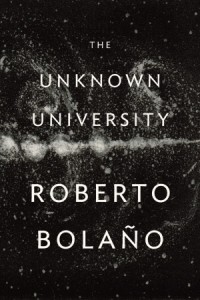 The Unknown University
The Unknown University
by Roberto Bolaño
New Directions, 2013
766 pages / $39.95 buy from Amazon
1. I’ve a strange attachment to Roberto Bolaño. One of coincidence and timing and love.
2. The Savage Detectives came out in the US six years ago, the same week I decided that—yeah, dammit—I was going to do an MFA.
3. I finished my MFA not too long ago (May-ish), just as the Bolaño Library seems to have exhausted its basement of posthumous manuscripts with The Unknown University, “a deluxe, bilingual edition of all the poems of the great Roberto Bolaño.” (Or so says the flap).
4. The Unknown University, really, reads more as a manuscript of notebooks. Poems incorporate drawings, caesuras become page-breaks, forms change again and again and again. At first, it reminded me of Jack Kerouac’s Mexico City Blues, in which every page of the book was in fact a typed page of a notebook’s musings. This feels like that, but rewritten from notebooks to computer and revised.
5. It’s 700+ pages and irresistible to a Bolañophile like me. A short story that recently ran in the New Yorker appears (“Mexican Manifesto”), as does the whole of the novel Antwerp, albeit in somewhat different form (and under the title “People Walking Away”). I didn’t do a full index-to-index comparison, but it also seems the whole of 2008’s The Romantic Dogs appears in a scattering throughout Part Three.
6. Despite these inclusions, though, The Unknown University isn’t a collection of previously-published books, like other “complete” collections can tend to be. (Just above my Bolaño shelf at home are the Collected Lydia Davis and Amy Hempel, which are exactly that).
7. Some such collections, like Jack Gilbert’s or Richard Hugo’s, have a section of “uncollected” pieces that follow the chronological reprintings. The Unknown University is sort of like one big “uncollected” section, but one that the author took the time to fashion into something that can live alone.
8. According to the note from the heirs: “The present edition corresponds exactly to the manuscript we found (with only a few minimal corrections taken off of his computer). Roberto himself dates it to 1993.”
9. These are early writings. An author’s note lists the completion of some sections as early as the 1970’s, when Bolaño was just Roberto, one of the boy-poet idealists he takes so often as subject in his fiction. In several poems he makes reference to his age (typically 26 or 27), which would have been around 1979-80.
10. One could imagine The Unknown University as the texts Bolaño wrote during the time of his writerly maturation, for what many now is the MFA. READ MORE >
August 22nd, 2013 / 11:00 am
25 Points: alphabet
 alphabet
alphabet
by Inger Christensen
New Directions, 2001
64 pages / $12.95 buy from Amazon
0. Inger Christensen—that petite, Danish demigod with her propensity for potted plants and the wild unknown—must have been hounded by the idea of growth. By what is massive. I guess if you look at/dwell on the vastness of things for long enough, you’ll predictably find yourself engaged with death options, the tempered dark where there are no underthings to stabilize you—and you are a little dust, alone with the chilling and the growing of yourself. It’s just you you you and the big outside.
1. Christensen’s alphabet is a sprawling network, shaped by the Fibonacci sequence that signifies nature’s inclination toward animal, exponential levels of growth and similar vanishings of decline. There’s an incantation stitching the poem, especially its beginning, that simply verifies the existence of things:
killers exist, and doves, and doves;
haze, dioxin, and days; days
exist, days and death; and poems
exist; poems, days, death
Death exists, details exist, the small monotony of days exist, all alongside one another.
1. I once read the entirety of alphabet in one of those concrete courtyards, the sad kind that’s trying to cute-up a hospital. I read it another time out loud for someone (although finishing was weird and uncomfortable because I was just beginning to tell, although I liked this person at the time, that they were not really interested in me and definitely not interested in 80-page metaphysical poems structured like the Fibonacci sequence), and another time on my bedroom floor with a whole .75 of OT that was looking nothing like a group sport because I was sad about something or something. And many times before and after that I can’t remember anymore. One magical person said, when I asked her about alphabet, that it made her think about cornfields a lot.
2. I sometimes try to relate my deep affection and appreciation for the state of Iowa, and I always think about cornfields that continue past the curvature of the earth, this massive output of production that literally exceeds our capacity to see it, much less understand it. “wheat in wheatfields exists, the head-spinning / horizontal knowledge of wheatfields, half-lives, / famine, and honey . . .”
3. Sometimes all it takes to be humbled is just the existence of certain things.
5. I’m shocked and quieted every time I read a newspaper, but not like I am by cornfields or incomprehensibly vast networks of connection. Although, the more I think about alphabet and re-live those declarations of both physical and metaphysical existences, the less I see the distinction.
8. There are some lines in there that simply state the death count for some great tragedies— “140,000 dead and / wounded in Hiroshima / some 60,000 dead and / wounded in Nagasaki”— and these numbers stand still on the page. The lines are always wavering between the porous and the immovable, the intimate and the intergalactic.
13. I wonder what it would look like, speaking of networks of connection, if Christensen had written a long poem/book of poems about the internet. Like, would that be beautiful? Would that be sheer terror?
21. It’s impossible not to talk about Susanna Nied’s translation. In an interview at Circumference last year, Neid said that she started working on alphabet’s translation in secret: “I didn’t tell Inger I was doing it. For the time being, I didn’t want anyone else’s input, not even hers. I had a very strong sense of what the poems could become in English. I kept shaping and reworking. Interlinked sprials. Double helix. Beauty and destruction. I was possessed.”
34. You can easily be possessed by Christensen. If you hear alphabet being read aloud, the words bend towards rapture, like hypnotism. Partly due to the steadily revolving repetitions—existence, vanishing, existence, vanishing. READ MORE >
June 11th, 2013 / 12:09 pm
25 Points: Antwerp
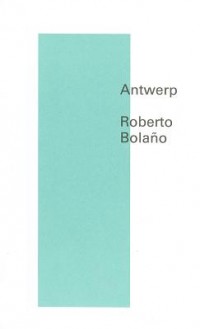 Antwerp
Antwerp
by Roberto Bolaño
New Directions, 2012
96 pages / $9.95 buy from Amazon
1. I wouldn’t say that this is the big bang of Bolaño’s fictional universe. I would say that it’s a baby fictional universe growing in the black hole of another baby fictional universe growing in the black hole of another baby fictional universe growing in the black hole.
2. This book has a lot of quotations without identified speakers. Without particularized mouths. As in how do we know who’s speaking or what it means to claim possession of a speech act. As in how do we know what’s Tupac and what’s a hologram of Tupac.
3. It’s like if I were to say to my computer, “say banana” and it said “banana,” and if this went on for a while with me saying words and my computer repeating them, until eventually I wrote down only my computer’s part of the exchange and made a novella out of it. Except that instead of saying banana I would say things like
“ The evening light dismantles our sense of the wind.”
4. Machines that move you. People in cars and trains, racing across highways and fields, going nowhere fast, towards a multiplicity of voided horizons.
5. Once I had a dream that was also a film I was directing where the main character kept experiencing acute disassociation from her body every time she got on an airplane or into a car, etc, and in the dream I (as the director and actress of the film) kept feeling the words “I’m not here.” I wish I could describe the torture of that feeling besides just calling it singular and unforgettable. Similar to the feeling of watching the movie Inception in the middle seat of an airplane flying over the ocean. Also, the feeling of reading this book, in certain moments.
6. There’s someone writing a story, the one you’re reading, and as the words are being written they’re simultaneously being picked up and examined by the characters in the story, or they’re splattering onto the car windshield of the man driving across the desert, who every few minutes catches himself looking down at his wrist despite the fact that he’s never worn a watch, not once in his life. i.e. “The word ‘teeth’ slid across the glass, many times.” Its pretty much how I feel about being human and having to die- like I have the vaguest awareness of myself as a decaying thing, but only enough to be a minor irritation to whomever(s) or whatever(s) may or may not have put me here.
7. One really great thing is how many of the short, one page “chapters” are actually scenes from the avant-garde porn film Bolaño wanted to make but never did. Or maybe he wanted someone else to read the book and do it for him. He even gave clues as to what he imagined the premiere would look like: a hunchback in the forest watching while someone ties a sheet to a pine tree with a thick piece of yellow cord and then says, smiling, “I’m going to show a film.”
8. This is one of those literary works that make me wish I’d studied quantum physics as a kid instead of making timelines.
9. At one point someone diagrams the changes in the affective landscape of a dream using straight-wavy-jagged line patterns and follows that with “nnnnnnnn” repeated, which is a really estranging onomatopoeia because I don’t seem to belong to the sound-world it’s referencing.
10. There’s a character who’s just called “the hunchback.” I’m not going to be corny and say that this was my favorite character in the book, except that I’m not sure there are any other characters. READ MORE >
April 4th, 2013 / 5:00 pm
New Exercises in Style
For its 65th anniversary, New Directions has just released an expanded edition of Raymond Queneau’s classic Oulipean text, Exercises in Style, featuring 25 previously untranslated exercises by Queneau, as well as new exercises by Jesse Ball, Blake Butler, Amelia Gray, Shane Jones, Jonathan Lethem, Ben Marcus, Harry Mathews, Lynne Tillman, Frederic Tuten, and Enrique Vila-Matas. If you’ve never experienced Queneau’s encyclopedia of ways to write the same scene over and over, each time new, there’s never been a better time.
On Feb 21st, at 8:00pm, there will be a launch party for the book in Brooklyn, info here.
Below, we’re happy to feature a few of the new exercises from the book.
COQ-TALE (first published in Arts, November 1954)
Ever since the bistros got closed down, we just have to make do with what we have. That’s why, the other day, I took a pub bus, at cocktail hour, on the N.R.F. line. No point in telling you that I had a terribly hard time getting in. I even had a permit, but IT WASN’T ENOUGH. It was also necessary to have an INVITATION. An invitation. They are doing pretty well, the R.A.T.P. But I managed. I yelled, “Coming through! I’m an Éditions Julliard author,” and there I was inside the pub bus. I headed straight for the buffet, but there was no way to get near it. In front of me, a young man with a long neck who hadn’t removed the Tyrolean hat with a plait around it that he wore – a lout, a boor, a caveman, obviously – seemed set on gobbling down every last crumb that was before him. But I was thirsty. So I whispered in his ear, “You know, back on the platform, Gaston Gallimard is signing contracts.” And off he ran, the sucker.
An hour later, I see him in front of the Gare Saint-Bottin, in the midst of devouring the buttons of his overcoat, which he had swapped for some
—Raymond Queneau
Translated by Chris Clarke
January 31st, 2013 / 2:25 pm
25 Points: Journey to the End of the Night
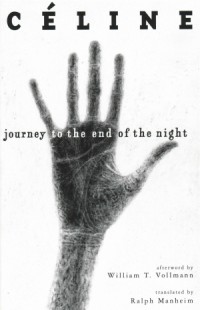 Journey to the End of the Night
Journey to the End of the Night
by Louis-Ferdinand Céline
New Directions, 2006
464 pages / $17.95 buy from New Directions
1. Will Self compared Joyce’s life before Ulysses to Céline’s experience in the war before writing Journey, in his exquisite discussion of the book upon some anniversary publication in The New York Times. I think I read that review about halfway through the novel and it complimented the thing quite well, gave a necessary contemporary slant on the whole thing.
2. Though remembered—much like Knut Hamsun—for his anti-Semitism (later in life) before his talents as an author after so many years gone by, a return to Céline and this novel in particular has occurred among authors and intellectuals almost every decade since its publication in 1932.
3. A new sort of manic transcription of the author’s experiences through his protagonist Ferdinand Bardamu jettisons the reader from war-torn France into the jungles of colonial Africa (my absolute favorite portion of any picaresque I’ve ever read) to post WWI America and back to France without missing a beat and yet the effect is akin to a hammer pounding against your chest.
4. I’ve read the book on three occasions, the last of which I suppose I felt ready enough and barreled through it in a couple of days and felt the aforementioned chest pounding that I’ve never experienced reading another book.
5. Its second translator, Ralph Manheim, also translated Adolf Hitler’s Mein Kampf.
6. Every time I remember that this is Céline’s first novel a little part of me that used to believe in writing as a career dies, then runs itself over in some hellish ghost tank, and dies again.
7. Famous for his use of three dots (“…”) in the sprawling paragraphs of his books, Céline—to me—has created a new and perfectly original way of de-Salinger-izing your first bildungsroman and turning it into a strange fucked up masterpiece.
8. Here we have the antihero, and the antihero’s doppelganger (in so many words) Robinson, who comes out of nowhere after any number of times to keep the protagonist company while he evades work, wanders around like a lunatic, and speculates about the desperate stupidity of mankind.
9. Bardamu’s a fan of kids, however; this being one of the few hopeful characteristics of the man. He believes in them, the promise of a good future, that maybe—just maybe—they won’t wind up shit like every adult he sees around.
10. The simplest characterization of this book is to say that it’s a picaresque, which is valid, but feels like the largest slight inflicted upon a great work of literature since everyone said all that shit that one time about your favorite whoever the hell; so I don’t want to do that. I want to call it a bible for people with less-than-hope but more-than-pettiness who hope to suck the congealed blood from the wounds of a better life forgone in the name of money, or democracy, or the nuclear family; and those who read it needing that companionship, needing that sense that all is not lost just yet, you’ll find it here. READ MORE >
November 1st, 2012 / 12:09 pm
